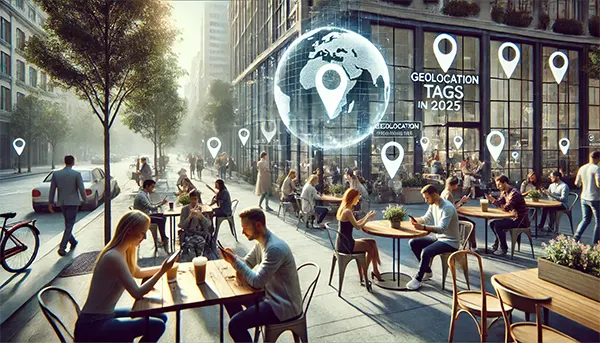The Impact of Geolocation Tags on the Popularity of Social Media Posts in 2025

In 2025, geolocation tags have become an integral part of social media strategies, influencing how posts are received by audiences. These tags, which provide the geographical context of a post, offer a range of benefits for both individuals and brands. By associating content with specific locations, users are more likely to engage with posts that are relevant to their geographic region. This article delves into the role of geolocation in the popularity of social media posts and its future impact.
The Rise of Geolocation Tags in Social Media
Geolocation tags have seen significant growth in recent years, with users increasingly incorporating them into their posts. The primary reason for this trend is the enhanced engagement these tags bring. Social media platforms like Instagram, Twitter, and Facebook allow users to add location-specific information, which can make content more discoverable by users in the same area. This geographical context not only aids in content personalization but also enhances the relevance of posts for local audiences. These tags also help businesses target their marketing efforts more effectively by focusing on a specific geographic area. As social media platforms continue to evolve, geolocation tagging is expected to remain a key feature in content sharing and audience engagement.
Geolocation tags are more than just a trend – they have become essential for effective social media engagement. Many users now expect to see posts tied to specific locations, as it increases the personal relevance of the content. For example, a local café may tag its location, making it easier for nearby users to find and engage with the content. This not only increases the chances of user interaction but also strengthens the connection between the brand and the local community. Brands that effectively use geotagging can enhance their local visibility and attract a larger, more relevant audience.
Moreover, the incorporation of geolocation tags has helped users connect with the world around them. Whether sharing a vacation photo or a post about a local event, these tags make it easier for individuals to engage with their surroundings. The rise of location-based services has made geotagging an invaluable tool for discovering nearby attractions, restaurants, and events. This shift towards hyper-localized content is likely to continue, as users increasingly seek content that is relevant to their immediate environment.
Why Geolocation Tags Matter for Local Audiences
Geolocation tagging has become crucial for targeting local audiences effectively. By including specific locations, users can engage with others in their immediate area, increasing the likelihood of interactions. For businesses, this is a vital tool for local marketing, ensuring their content reaches the most relevant individuals within their geographic region. Additionally, geolocation tags help social media users discover new places, events, and activities happening near them, making the content more engaging. This local connection fosters a sense of community and encourages users to engage with posts they can relate to, strengthening the overall social experience. As a result, businesses that leverage geolocation tags can benefit from higher engagement rates, increased foot traffic, and improved brand recognition within specific locations.
Another benefit of geotagging for local audiences is its ability to personalize content. For example, when users search for a local event or business, geotagging ensures that relevant posts are shown to them. This increases the chances that the content will resonate with the viewer, leading to higher interaction levels. For businesses, this means that social media posts can generate more qualified leads. By making content more localized and personalized, brands can tap into an audience that is not only more likely to engage with the post but also more likely to become loyal customers.
Geolocation tags also help foster a sense of community, as they allow users to connect with others who share similar interests or live in the same area. Whether it’s a local meet-up, a pop-up event, or a new product launch, geotagging makes it easier for individuals to discover and participate in local activities. This strengthens community ties and can also drive in-person interactions, further deepening the connection between brands and their audience.
Geolocation Tags and User Engagement: A Symbiotic Relationship
The relationship between geolocation and user engagement has proven to be mutually beneficial. Posts with geolocation tags tend to generate higher levels of interaction, as they are more likely to be shared and commented on by users with a direct connection to the location. This interaction not only boosts the visibility of a post but also helps build a stronger sense of community within a specific area. When users are able to connect with content that is relevant to their location, they feel more personally involved and are more likely to share or engage with the post. This results in a network effect where the visibility of posts continues to grow, leading to increased organic reach and enhanced social media presence.
For brands, leveraging geolocation tags is a powerful strategy for improving visibility. When users tag a brand’s location, it generates organic traffic and attracts more local followers, increasing the brand’s exposure within a particular region. This organic growth can significantly improve brand awareness, especially in competitive markets where standing out can be challenging. Additionally, geolocation allows businesses to tailor their marketing strategies to specific demographics, making their campaigns more targeted and efficient. With the right geolocation strategy, businesses can foster a loyal customer base and create long-term engagement by continually delivering content that resonates with local audiences. As the power of geotagging continues to grow, brands that capitalize on this feature will likely gain a competitive edge in their respective markets.
Geolocation tags also have the potential to create more authentic interactions between users and brands. By connecting people to real-world locations and events, these tags facilitate genuine connections based on shared interests. As users engage with content tied to specific locations, they feel a stronger sense of connection to the brand or event. This creates more meaningful interactions that can lead to increased loyalty and positive word-of-mouth recommendations, further driving the popularity of social media posts.
Impact on Brand Visibility and Awareness
The use of geolocation tags can significantly impact a brand’s visibility and awareness. By tagging locations in posts, businesses can attract local audiences and increase their reach within specific geographic areas. This increased local engagement not only boosts the visibility of posts but also makes it easier for potential customers to discover brands they may not have encountered otherwise. When users tag a location, they help spread the brand’s message to others who are likely to have an interest in the content. This organic growth can help businesses establish a stronger local presence and improve customer acquisition rates.
Additionally, geolocation tags play an important role in building brand credibility. When users see posts tagged with locations they recognize or frequent, it helps build trust in the brand. It signals to followers that the business is connected to their community and can offer relevant products or services. As a result, geolocation can help businesses position themselves as local authorities, fostering greater customer loyalty and repeat business. This localized approach to branding is essential in today’s competitive market, where authenticity and community involvement are key drivers of success.
With the increasing importance of geolocation, brands are being given the opportunity to explore new avenues for marketing and audience engagement. The combination of local visibility, community engagement, and brand credibility creates a powerful tool for businesses looking to connect with customers on a more personal level. As technology continues to advance, the potential for geolocation to shape the future of marketing and social media interactions will only continue to grow.

The Future of Geolocation Tags: What’s Next?
As we move further into 2025, the future of geolocation tags looks promising. With the rise of augmented reality (AR) and virtual reality (VR), the integration of location-based data could evolve, offering even more personalized and immersive experiences for users. Additionally, businesses are expected to rely more heavily on geolocation to run targeted campaigns that can further personalize the content they deliver to users. These advancements are expected to make geolocation a more integral part of both social media interactions and marketing strategies. As these technologies mature, the way geolocation data is used will likely expand to include even more dynamic and interactive experiences for users, such as AR-powered location-based games or VR environments that incorporate real-world geotagged content.
With these technological advancements, geolocation tags are set to play a more central role in shaping how users interact with digital content. As AR and VR technologies become more mainstream, users will be able to experience geotagged content in new, interactive ways. For example, they could explore virtual tours of real-world locations, engage with interactive maps, or participate in location-based gaming experiences. This evolution of geolocation technology offers exciting possibilities for both users and brands, providing new opportunities for engagement and creativity.
Moreover, as brands continue to experiment with new ways to incorporate geolocation into their marketing strategies, we can expect to see more personalized and immersive experiences for consumers. From virtual events to interactive advertising, the future of geolocation in social media is bound to offer countless new opportunities for brands to connect with their audiences. As the technology continues to evolve, geolocation tags will remain a key element in driving user engagement, fostering community connections, and helping businesses reach their target audiences with greater precision.
Incorporating AR and VR with Geolocation
Augmented reality and virtual reality technologies are poised to revolutionize how geolocation data is used in social media. These technologies can create immersive, location-based experiences, such as virtual tours or interactive maps, where geotagging plays a pivotal role in enhancing the user experience. As these technologies mature, geolocation tagging will likely evolve to become an even more powerful tool for marketers and social media users alike. The use of geolocation in AR and VR settings will enable users to explore and interact with their surroundings in new ways, while also allowing brands to create highly personalized and engaging experiences that resonate with their audiences. By incorporating geolocation with AR and VR, the potential for innovative marketing strategies is vast, offering opportunities for both creativity and audience engagement that were previously unimaginable.
As geolocation tags continue to evolve alongside advancements in technology, their role in shaping user experiences and brand interactions will only grow. The integration of AR and VR with geolocation has the potential to transform how consumers engage with content, making it more immersive and personalized. Brands that embrace these technologies will be well-positioned to provide cutting-edge experiences that captivate their audiences and set them apart from competitors. This shift towards more interactive, geotagged content represents a new frontier in digital marketing that promises to reshape the landscape of social media and advertising.
In conclusion, the future of geolocation tags is full of promise. With the integration of AR, VR, and other emerging technologies, geolocation is set to become a central part of social media and digital marketing strategies. As brands continue to leverage geotagging, they will be able to create more personalized, engaging experiences for their audiences, further enhancing the popularity and reach of their content. The power of geolocation in 2025 is just the beginning of a new era of digital engagement that promises to deliver greater connectivity, creativity, and user interaction.
